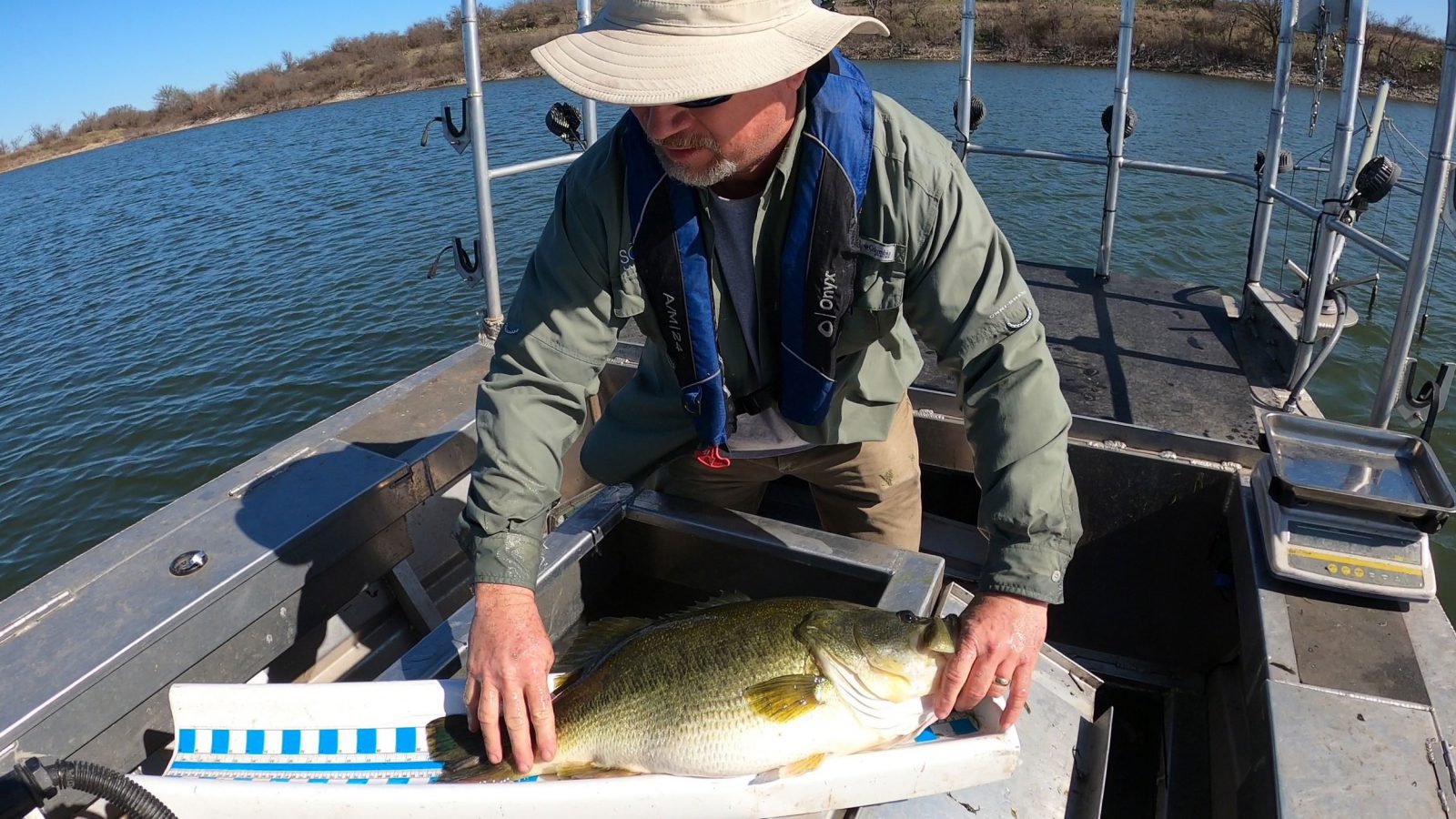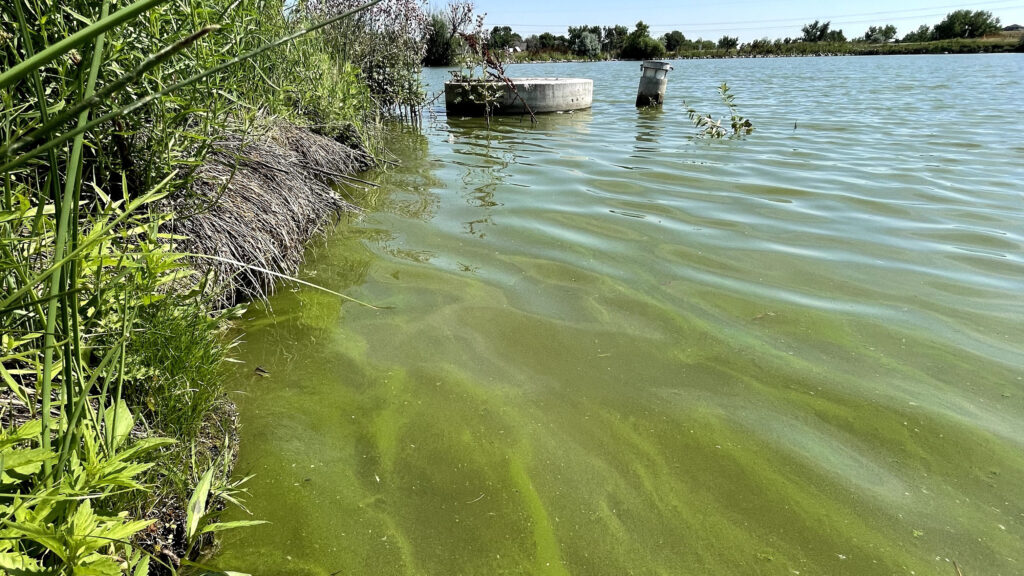
The Key to Building a Trophy Bass Fishery
Establishing and maintaining an ideal plankton bloom can be one of the most challenging and frustrating components of producing a trophy fishery. Some ponds naturally produce the perfect bloom, while others continually produce undesired aquatic growth. Taming a waterbody’s undesired vegetation and algae is something that requires assertive action with oftentimes zero-tolerance for undesired species. With enough experience, most pond managers can develop an instinctive eye for interpreting a pond’s current state, allowing accurate management strategies to be implemented in a swift manor.
The goal of producing and maintaining a trophy bass fishery means that the waterbody needs to produce and maintain algae species that work their way up the food chain. To achieve this, undesired algae and vegetation species will need to be eradicated, and desired algae species need to be promoted.
If timid when establishing a productive pond, the fishery will typically not produce the bio-mass of forage required to pack the pounds on your predators. Additionally, if methods are not aggressive enough, you run the risk of giving too much control to Mother Nature. On the other hand, if your approach is too aggressive, you can unintentionally promote too much undesired aquatic growth or even worse, instigate an oxygen crash. This gray area known as nutrient management is oftentimes the difference maker between a pond manager’s success or failure.
One of the most important concepts to grasp is that waterbodies have their own rhythm. This rhythm, which is often referred to as the ponds balanced state, is at the core of properly establishing and maintaining a desired plankton bloom.
If a pond is naturally producing a phytoplankton bloom, then it is safe to say that pond is in a rhythm that favors phytoplankton production. In this scenario, a pond manager will likely need to maintain or improve the blooms’ density by adding fertilizer throughout the growing season, while also keeping any undesired vegetation and algae growth in check through regular monitoring and treating as undesired species try to establish. A pond in the correct rhythm of ideal plankton production is easier to manage, and much more capable of maintaining a thriving forage fish base, than a pond which struggles to maintain a good plankton bloom.

Breaking the Cycle: Tools and Strategies for Transforming Unproductive Waterbodies
For waterbodies that naturally gravitate towards nuisance aquatic vegetation or algae, one must break the pond’s unproductive rhythm and take the pond out of its established comfort zone. This process of disrupting a pond’s balance often sets off a chain reaction where various aquatic plants and algae species take advantage of the pond’s vulnerability and available nutrient load. For those in this position, it is critical to understand undesired plants and algae species are not the problem, but rather a symptom of the waterbody’s nutrients. The biggest key to successfully altering the waterbody and turning nutrients into fish flesh is to implement the proper tools available to you.
Knowing what tools to use at what time relates entirely to your pond’s characteristics and the challenges it faces. These tools include things like limestone, aeration, herbicides, algaecides, beneficial aquatic vegetation, fertilizers, phytoplankton, algae identification, and water quality testing. The best tools for each pond will vary, and deciding when to implement them will be an ongoing task. That’s part of what you, as a pondmeister, need to figure out.
For those who are unsure what steps need to be taken, it is best to start by looking at water quality to gain an understanding of your baseline conditions. A profile of the water column’s dissolved oxygen and temperature can be an indicator of underlying issues. Additional testing can be completed to learn about alkalinity, hardness, pH, conductivity, turbidity, chlorophyll a, and nutrients such as total phosphorous, nitrate, nitrite, and total nitrogen. With the right baseline of information, necessary improvements and management strategies can become apparent.
One of the most important water quality parameters to figure out is your pond’s alkalinity level. Ideally, you want alkalinity above 50 parts per million (ppm), but at minimum it should be above 20 ppm. Here in the mid-Atlantic, where I am located, many fertilized ponds are naturally below 20 ppm and need agricultural limestone added to raise alkalinity levels. In my experience, ponds with alkalinity levels around the 20 ppm range can be much more difficult to get in a rhythm that consistently gravitates towards ideal plankton production when compared to ponds with harder water.
Another tool to consider for trophy fisheries is bottom diffused aeration. Aeration has significant benefits, and helps ponds maintain a productive rhythm throughout the growing season. Many ponds that produce good plankton blooms throughout the spring and early summer have the tendency to produce undesired cyanobacteria, or blue-green algae, blooms during the later summer months. This is a natural rhythm for most waterbodies, and steps typically need to be taken to maintain productive green algae species throughout the entire growing season. Blue-green algae are undesired because they do not work their way up the food chain, and are also capable of producing harmful toxins. Unfortunately, blue-green algae are frequently overlooked by managers due to the fact that a blue-green algae bloom can look similar to a phytoplankton bloom. When managing for desired green algae species (i.e. phytoplankton) that work their way up the food chain, keep in mind that blue-green algae typically prefer a more phosphorous rich environment, while green algae prefer a nitrogen rich environment.
The reason bottom diffused aeration is a must have for productive fisheries is because it reduces stratification. Stratified ponds can accumulate greater levels of phosphorus in deeper water due to organics naturally settling out. Once the deeper water goes anoxic, high levels of accumulated phosphorus start becoming available. This spike in phosphorus favors blue-green algae and gives them an edge over desirable green algae species.

Mastering Pond Management: Strategic Algaecide Use and Nutrient Balance for Trophy Fisheries
Even with an aeration system, blue-green algae can still out-compete desirable green algae species and take over an ecosystem. If the shift from green to blue-green is noticed early on, low rates of copper-based, or peroxide-based algaecides can be applied to eradicate the blue-greens without eradicating desired algae species. If blue-greens hang around too long, they tend to outcompete green algae and can cause the population of green algae to diminish significantly. To help an untrained eye stay ahead of this issue, water samples can be analyzed monthly to identify algae species within the bloom.
Eradicating undesired vegetation and algae species while promoting desired plankton and algae species is likely the most challenging process to the average pond manager. If herbicides and algaecides were inexpensive, then this may not be such a challenging task, but the reality is, treating ponds can be expensive. From my experience, this is where many pond managers do not make management decisions in alignment with their goals. It is often times cost effective to take an assertive approach when treating nuisance vegetation and algae, as opposed to taking a timid approach. Spot treating plants with lower than necessary rates of contact herbicides is a common error made by many. Follow the label. Another common error is the use of substandard spray equipment or ineffective application techniques.
Nowadays, pond managers have an arsenal of aquatic herbicides and algaecides that provide both broad and selective treatment options. The array of treatment options allows precise adjustments to be made. This process allows one to accurately shift the nutrient load and maintain a high quality plankton bloom throughout the entire growing season.
The pesticides required will depend on the site characteristics as well as the species which need control. Systemic herbicides are frequently the best type of herbicides to use when making the shift from undesired aquatic vegetation to a plankton bloom. For many ponds it can be cost effective to treat with fluridone annually, or even every second or third year depending on the circumstances. Fluridone is one of the more expensive herbicides on the market, but its ability to control nearly all types of submersed and floating vegetation, without controlling algae species make it a great herbicide for ponds being fertilized. If applied at the correct rate per the label, and applied with the correct formulation, it can provide outstanding vegetation control. When treating with fluridone, the nutrient load has only a few directions it can go, allowing managers to produce a desired plankton boom more easily.
Although fluridone is a choice herbicide, many other herbicides are also good candidates for a fertilizing program. Choosing the correct herbicide depends on water flow, vegetation species that need control, water chemistry, turbidity, type of substrate, time of year, state regulations, and water uses, among other factors. With the number of herbicides available and the nearly endless scenarios that present themselves to pond owners, it is difficult to prescribe what may work best for your situation. As a general rule of thumb, systemic herbicides will provide control for a longer period of time than contact herbicides, so for that reason, many people gravitate towards systemic options. If you are unsure what herbicide is the correct choice for your management strategy, consult with a professional biologist who has experience with a wide variety of herbicides. They can help point out the best strategy for your particular situation, and possibly complete the applications for you or provide you with the necessary product.
Raising trophy caliber fish is not for everyone due to the financial commitment it takes. Those looking to truly maximize growth on an annual basis will need to invest in the fundamental basics that will lead to success. Furthermore, as the waterbody requires limestone, aeration, herbicide and algaecide treatments, fertilizer, water testing and algae identification, it is critical that the waterbody’s manager has the freedom required to act as swiftly as necessary to keep the fisheries productivity at full speed. For those looking to master the art of nutrient management, keep in mind that Mother Nature cannot be controlled; only encouraged.









